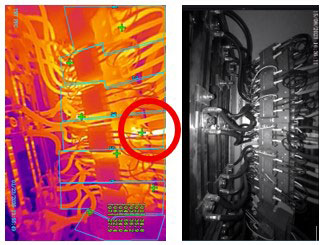Infrared Eyes on the Inside: Continuous thermal monitoring is transforming wind Farm O&M
As wind turbines keep growing taller and more remote, operations and maintenance teams responsible for caring for nacelle equipment face increasing cost and risk. Industry models place O&M at roughly one third of a wind plant’s life‑cycle cost, and offshore studies report that O&M consumes about 25 to 30 percent of lifetime expenditure for many projects. Every tower climb, vessel trip, or helicopter flight adds time, money, and risk. Innovations in infrared camera systems tied to reliable machine learning capabilities now make it possible to monitor nacelle electrical and mechanical components continuously from remote locations.
.jpeg)
From static snapshot to continuous insight
Handheld infrared (IR) cameras had become maintenance staples long before NFPA 70B formally codified thermographic inspection for electrical equipment. Technicians use them to reveal incipient problems such as loosening bus‑bar connections, generator winding shorts, or bearing wear. The method works, though their use inside a wind turbine nacelle while it's under power is extremely dangerous and generally avoided.
High-voltage electricity is consistently present in the nacelle’s components, including the generator, wiring, and electrical systems. This poses a severe risk of electric shock, arc flashes, and thermal burns — all of which can be fatal. Even when the turbines blades are in parked condition, the internal mechanisms (gearboxes, drive trains, cooling systems) can contain stored energy or move unexpectedly, leading to crushing injuries, being struck by moving parts, or amputations.
Even in the best of circumstances, handheld IR cameras record only a single moment. This time-based maintenance relies on being at the right place at the right time and is further dependent on weather and technician skill.
.jpg) Miniaturized, rugged IR cameras and their software have transformed this model. Cameras no larger than a deck of cards can be attached in or near to converter cabinets, yaw‑drive housings, or hydraulic power units. When magnetically mounted to the door of electrical cabinets, energized parts can be monitored remotely without opening panels — preserving ingress protection ratings and keeping technicians outside arc‑flash boundaries. The sensors capture temperature information day and night, and the accompanying software send pre-determined alerts, meaning no human monitoring is required once the products are installed.
Miniaturized, rugged IR cameras and their software have transformed this model. Cameras no larger than a deck of cards can be attached in or near to converter cabinets, yaw‑drive housings, or hydraulic power units. When magnetically mounted to the door of electrical cabinets, energized parts can be monitored remotely without opening panels — preserving ingress protection ratings and keeping technicians outside arc‑flash boundaries. The sensors capture temperature information day and night, and the accompanying software send pre-determined alerts, meaning no human monitoring is required once the products are installed.
A recent review of infrared thermography for power‑equipment monitoring notes that this technique excels where safety, cost, and time must be optimized. A rise of only a few degrees is often the first indicator of insulation breakdown or lubrication failure. An automatic email alert sent as soon as the temperature crosses a specific threshold can alert personnel long before the vibration thresholds trip or smoke detectors activate.
Condition‑based maintenance becomes routine
Continuous thermal camera data makes true condition‑based maintenance possible. Analytic platforms learn each component’s normal temperature pattern and flag deviations automatically. If a generator end winding climbs five degrees above its seasonal baseline, the system emails a report to the planner, who can schedule the repair during a low‑wind period and send the correct spare parts the first time.
Condition‑based maintenance also supplies objective evidence for insurers and warranty providers. An archived thermal timeline shows that an over‑temperature alarm was handled promptly — a valuable record if questions arise later.
Offshore wind: Fewer climbs, lower exposure
The farther a turbine sits from shore, the more valuable remote diagnostics become. A recent Bureau of Safety and Environmental Enforcement study on remote inspection technologies concludes that deployment reduces the need for technicians to work offshore and lowers costs at the same time. Service providers now report operational cost savings between 35 and 80 percent for drone and robotic inspections compared with traditional methods.
Infrared camera networks fit neatly into this remote‑first model. Instead of climbing every nacelle every quarter, crews can review thermal dashboards from a control room and travel only when temperature alarms require it. Implementing this at a one‑hundred‑turbine array forty nautical miles offshore would eliminate two preventive climbs per turbine per year, preventing two hundred ascents and scores of vessel days. Not only would this cut fall hazards, fatigue, and carbon emissions, but it would add productive megawatt‑hours to the revenue column. Diagnostic use of these cameras has also shown to enhance safety and lower the number of climbs needed at large wind farms.

Integrating thermal data with digital twins
Modern infrared cameras export standard protocols such as ONVIF and Modbus, so their data stream can merge with vibration, lubrication, and meteorological inputs. Digital‑twin platforms then correlate values across these sources. A rising stator temperature paired with elevated reactive power might justify a controlled derating until technicians can intervene, avoiding collateral damage.
Looking ahead
For utility operators and maintenance professionals, the message is straightforward. Embedding infrared “eyes” inside each turbine turns the nacelle from a black box visited on a calendar day into a continuously observed asset. The shift increases availability, reduces costs, enhances crew safety, and enables the rapid growth of onshore and offshore capacity.
Troy Goss is the Product and Sales Manager at SYTIS, which delivers innovative thermal and optical imaging technology with 24/7 real-time alerting, remote monitoring, and actionable reporting. SYTIS empowers teams to make faster, safer and more informed decisions from any device.
SYTIS | www.sytis.com
Works Cited
DNV. Evaluation of Remote Inspection Technologies (RIT) for Offshore Wind Assets. Report No. 10311530‑HOU‑R‑01‑B, prepared for the U.S. Bureau of Safety and Environmental Enforcement, 2023. https://www.bsee.gov/sites/bsee.gov/files/2023-03/802ac.pdf
Hammond, Rob, and Aubryn Cooperman. Windfarm Operations and Maintenance Cost‑Benefit Analysis Tool (WOMBAT). NREL/TP‑5000‑83712, National Renewable Energy Laboratory, 2022. https://docs.nrel.gov/docs/fy23osti/83712.pdf
National Fire Protection Association. NFPA 70B: Recommended Practice for Electrical Equipment Maintenance. 2023 ed., NFPA, 2023. https://www.nfpa.org/codes-and-standards/nfpa-70b-standard-development/70b
Omara, Ahmed, et al. “Remote Wind Turbine Inspections: Exploring the Potential of Multimodal Drones.” Drones, vol. 9, no. 1, 2025, pp. 1‑59, doi:10.3390/drones9010004. https://www.mdpi.com/2504-446X/9/1/4
Severe, Ryan. “Success Applying Continuous Infrared Camera Technology and Software at Puget Sound Energy.” SYTIS, SYTIS, 10 July 2024, www.sytis.com/articles/success-applying-continuous-infrared-camera-technology-and-software-at-puget-sound-energy.
Ukiwe, Ezechukwu K., et al. “Techniques of Infrared Thermography for Condition Monitoring of Electrical Power Equipment.” Journal of Electrical Systems and Information Technology, vol. 10, 2023, article 49, doi:10.1186/s43067‑023‑00115‑z. https://jesit.springeropen.com/articles/10.1186/s43067-023-00115-z
Author: Troy Goss
Volume: 2025 September/October








